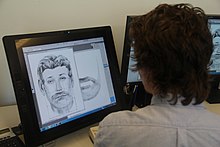Phantom image
A phantom image (in Switzerland a robot image ) is a police tool used to identify the offender and is also used to reconstruct the faces of crime victims or archaeological finds.
history
Initially, the most realistic possible pictures of a perpetrator were created from testimonies by appropriately trained draftsmen. The work has been made easier by developing a so-called Identikit . With this procedure, there are sketches of all facial features that are differently pronounced on foils , which can be superimposed and thus put together to form a complete face . These foils contain the face shape, different hair types, eyebrows, eyes, ears, noses, mouths, chin shapes and so on, among other things. Parts of the image based on photographs and which can then be put together and linked or changed by drawing were also produced.
After the usual in Germany for these sets of image parts designation P ersonen- I dentifizierungs- K artei the term also formerly used for ghost images was spades image derived. If the face in this collection of images is broken down into five individual strips (forehead with hairline, eye area, nose area, mouth area and chin) and there are 200 different images to choose from from each area, this theoretically allows 320 billion possible combinations.
Further simplification for the creation of phantom images resulted after the development of the computer with software that enables photorealistic representations and accelerated production. In order not to give the impression that the images are about already caught perpetrators, black and white images are still preferred for phantom images, even if colored images are now technically possible without any problems.
Process with which conclusions from the genetic material , d. H. of individual deoxyribonucleic acid (DNA), inferring the phenotype of an individual is called DNA phenotyping ; However, such methods cannot yet be used reliably to create a usable phantom image on the basis of phenotypic conclusions. Not to be confused with this is a genetic analysis of the DNA; this is also referred to in a figurative sense as a genetic phantom image .
Profilers also use psychological findings to create what is known as a psychological phantom image of offenders.
Examples
Phantom image of Paulus von Tarsus , LKA NRW, 2008
Timothy McVeigh (right), Oklahoma assassin
See also
Web links
Individual evidence
- ^ Eduard Zimmermann: The invisible network , Munich 1970, p. 246.
- ↑ Leila Knüppel: Draftsman: "Did he have wrinkles, a wart, scars?" , Spiegel Online from November 22, 2011, accessed on February 7, 2019.
- ↑ Nina Golombek: Why black and white phantom images are more successful , welt.de from May 23, 2017, accessed on February 7, 2019.
- ↑ nzz.ch: Draw a phantom picture with DNA


